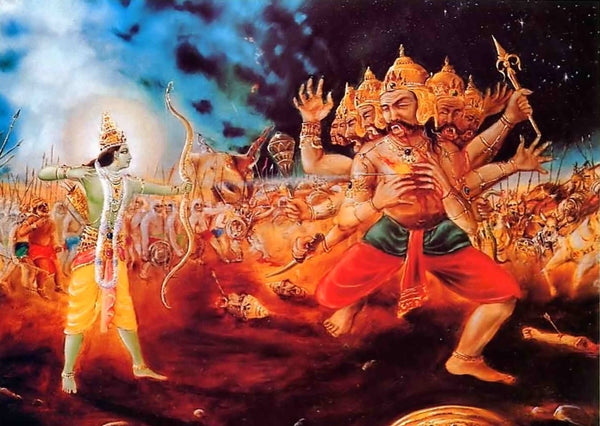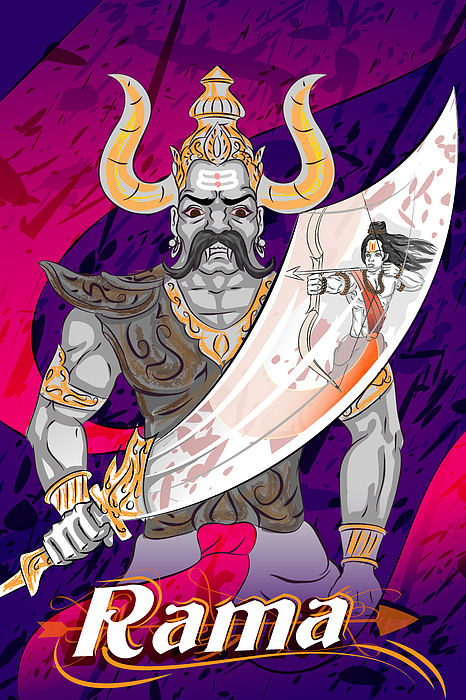
When the battle finally takes place, Rama is successful, and Ravana was killed.
#In the ramayana the demon king ravana was protected by series
Through a series of tricks and manipulations, Ravana kidnapped Sita and transported her in his aircraft to be held captive in Lanka.Īfter Rama hears of his wife’s abduction from his new friend Hanuman, he is put through more tricks and manipulations all set in motion to both keep Rama from finding his beloved and drawing him toward an ultimate battle. Part of this was the kidnapping of his enemy’s wife, Sita. Learning of his sister’s death at the hand of Rama’s armies, he vowed to avenge her by destroying Rama and finishing what his sister set out to do. This was done because of the killing of Ravana’s sister when she attempted to take the life of Sita and destroy Raman’s empire. The Yuda Kanda, which is the sixth book in the Ramayan tells the story of the battle between Rama and Ravana’s armies over the kidnapping of Rama’s wife, Sita. Hanuman whom is carring Rama and Lakshmana while rescuing them from the demon Ahiravana (also known as Mahiravana) This has led some to speculate that the story is more than a mere legend, but rather an account that may have some historical accuracy. Although Rama is portrayed in the Hindu legends as being a representative of the divine being Vishnu, in the actual Ramayana, there is very little reference to their connection. The writings are said to date back to somewhere between 300 and 400 AD. The epic is 24,000 verses written in anustubh, or 32 syllables per meter. It tells the journey of Rama, and his battle against Ravana, who ruled Lanka, the area that is now known as Sri Lanka.

It describes what the ideal relationships are as far as family interaction, showing the duties of each one as well as the ramifications of ignoring those duties for personal gain.

The tale of the Ramayana is one of two epics written by the sage Valmiki, the other being Mahabharata. The Ramayana Epic Tales Angkor temples: this is one of many of the walls that has a carving of the great battle that took place between Ramayana and Rama and the ten headed and 20 armed Ravana. Maha-eliya, (the area now referred to as “Horton’s Plains”) Ussangoda in Hambanthota and Wariyapola.still have these marks on their landscape and with the discovery of this ancient coffin the story of Ramayana may have been more than just a myth. There have been speculations of three areas in Sri Lanka being the possible landing strips for these aircraft–and to look at the area today, there are indentations marked there for centuries that appear to have been purposely created for the purpose of landing an airplane. Keep in mind, this was 10,000+ years ago, centuries before air travel was thought to have been possible. Indeed, it was even said that he had five landing strips for his flying machines. The Ravana Axel what was this item used for could it have been part of a flying machine that we have yet to uncover yet or maybe we have and just don't know what it is yet. It has been used to refer to the thrones that the gods were seated in as well as ‘flying chariots” that were said to be possessed by Ravana. It was said that Ravana had access to ‘Pushpak Viman’ In Sanskrit, viman or vimana translates to measuring out or traversing.

The significance of these findings could indeed answer some vital questions about ancient man and exactly what human beings were capable of accomplishing. For it was, many believe, not just any coffin but rather the coffin of the enemy in the Ramayana tale–Ravana. The Ramayana is one of two epics allegedly written by Valmiki that many scientists in Sri Lanka had written off as being merely an old tale until the discovery of a very old coffin and some stones got the entire community in a state of wonder. In 2008, it was reported that the mountain area of Noroliya had unearthed some very interesting discoveries that have caused some to believe that maybe the Hindu legends of old were not merely fables. It is the Hindu story of Ramayana and the evidence that the antagonist of the tale, Ravana, may actually have existed. However, one ancient story that has been regarded as simply an old legend may have some basis in reality. Rarely though, is evidence found to conclusively link ancient legends to something tangible. It has been theorized that some of the gods and goddesses of mythologies may have been representations of world leaders of the times.


 0 kommentar(er)
0 kommentar(er)
